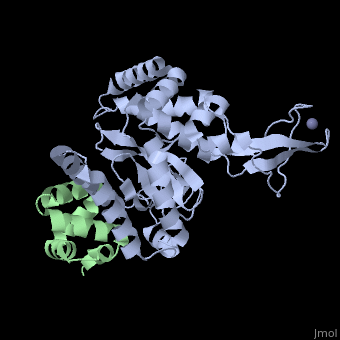2f4m
From Proteopedia
(Difference between revisions)
| Line 3: | Line 3: | ||
== Structural highlights == | == Structural highlights == | ||
<table><tr><td colspan='2'>[[2f4m]] is a 2 chain structure with sequence from [http://en.wikipedia.org/wiki/Mus_musculus Mus musculus]. Full crystallographic information is available from [http://oca.weizmann.ac.il/oca-bin/ocashort?id=2F4M OCA]. For a <b>guided tour on the structure components</b> use [http://oca.weizmann.ac.il/oca-docs/fgij/fg.htm?mol=2F4M FirstGlance]. <br> | <table><tr><td colspan='2'>[[2f4m]] is a 2 chain structure with sequence from [http://en.wikipedia.org/wiki/Mus_musculus Mus musculus]. Full crystallographic information is available from [http://oca.weizmann.ac.il/oca-bin/ocashort?id=2F4M OCA]. For a <b>guided tour on the structure components</b> use [http://oca.weizmann.ac.il/oca-docs/fgij/fg.htm?mol=2F4M FirstGlance]. <br> | ||
| - | </td></tr><tr><td class="sblockLbl"><b>[[Ligand|Ligands:]]</b></td><td class="sblockDat"><scene name='pdbligand=CL:CHLORIDE+ION'>CL</scene>, <scene name='pdbligand=ZN:ZINC+ION'>ZN</scene>< | + | </td></tr><tr id='ligand'><td class="sblockLbl"><b>[[Ligand|Ligands:]]</b></td><td class="sblockDat"><scene name='pdbligand=CL:CHLORIDE+ION'>CL</scene>, <scene name='pdbligand=ZN:ZINC+ION'>ZN</scene></td></tr> |
| - | <tr><td class="sblockLbl"><b>[[Related_structure|Related:]]</b></td><td class="sblockDat">[[2f4o|2f4o]]</td></tr> | + | <tr id='related'><td class="sblockLbl"><b>[[Related_structure|Related:]]</b></td><td class="sblockDat">[[2f4o|2f4o]]</td></tr> |
| - | <tr><td class="sblockLbl"><b>[[Gene|Gene:]]</b></td><td class="sblockDat">Rad23b, Mhr23b ([http://www.ncbi.nlm.nih.gov/Taxonomy/Browser/wwwtax.cgi?mode=Info&srchmode=5&id=10090 Mus musculus])</td></tr> | + | <tr id='gene'><td class="sblockLbl"><b>[[Gene|Gene:]]</b></td><td class="sblockDat">Rad23b, Mhr23b ([http://www.ncbi.nlm.nih.gov/Taxonomy/Browser/wwwtax.cgi?mode=Info&srchmode=5&id=10090 Mus musculus])</td></tr> |
| - | <tr><td class="sblockLbl"><b>Activity:</b></td><td class="sblockDat"><span class='plainlinks'>[http://en.wikipedia.org/wiki/Peptide-N(4)-(N-acetyl-beta-glucosaminyl)asparagine_amidase Peptide-N(4)-(N-acetyl-beta-glucosaminyl)asparagine amidase], with EC number [http://www.brenda-enzymes.info/php/result_flat.php4?ecno=3.5.1.52 3.5.1.52] </span></td></tr> | + | <tr id='activity'><td class="sblockLbl"><b>Activity:</b></td><td class="sblockDat"><span class='plainlinks'>[http://en.wikipedia.org/wiki/Peptide-N(4)-(N-acetyl-beta-glucosaminyl)asparagine_amidase Peptide-N(4)-(N-acetyl-beta-glucosaminyl)asparagine amidase], with EC number [http://www.brenda-enzymes.info/php/result_flat.php4?ecno=3.5.1.52 3.5.1.52] </span></td></tr> |
| - | <tr><td class="sblockLbl"><b>Resources:</b></td><td class="sblockDat"><span class='plainlinks'>[http://oca.weizmann.ac.il/oca-docs/fgij/fg.htm?mol=2f4m FirstGlance], [http://oca.weizmann.ac.il/oca-bin/ocaids?id=2f4m OCA], [http://www.rcsb.org/pdb/explore.do?structureId=2f4m RCSB], [http://www.ebi.ac.uk/pdbsum/2f4m PDBsum]</span></td></tr> | + | <tr id='resources'><td class="sblockLbl"><b>Resources:</b></td><td class="sblockDat"><span class='plainlinks'>[http://oca.weizmann.ac.il/oca-docs/fgij/fg.htm?mol=2f4m FirstGlance], [http://oca.weizmann.ac.il/oca-bin/ocaids?id=2f4m OCA], [http://www.rcsb.org/pdb/explore.do?structureId=2f4m RCSB], [http://www.ebi.ac.uk/pdbsum/2f4m PDBsum]</span></td></tr> |
| - | <table> | + | </table> |
| + | == Function == | ||
| + | [[http://www.uniprot.org/uniprot/RD23B_MOUSE RD23B_MOUSE]] Multiubiquitin chain receptor involved in modulation of proteasomal degradation. Binds to polyubiquitin chains. Proposed to be capable to bind simultaneously to the 26S proteasome and to polyubiquitinated substrates and to deliver ubiquitinated proteins to the proteasome. May play a role in endoplasmic reticulum-associated degradation (ERAD) of misfolded glycoproteins by association with PNGase and delivering deglycosylated proteins to the proteasome.<ref>PMID:12815074</ref> <ref>PMID:15336624</ref> <ref>PMID:16709668</ref> Involved in global genome nucleotide excision repair (GG-NER) by acting as component of the XPC complex. Cooperatively with Cetn2 appears to stabilize Xpc. May protect Xpc from proteasomal degradation (By similarity).<ref>PMID:12815074</ref> <ref>PMID:15336624</ref> <ref>PMID:16709668</ref> The XPC complex is proposed to represent the first factor bound at the sites of DNA damage and together with other core recognition factors, Xpa, RPA and the TFIIH complex, is part of the pre-incision (or initial recognition) complex. The XPC complex recognizes a wide spectrum of damaged DNA characterized by distortions of the DNA helix such as single-stranded loops, mismatched bubbles or single stranded overhangs. The orientation of XPC complex binding appears to be crucial for inducing a productive NER. XPC complex is proposed to recognize and to interact with unpaired bases on the undamaged DNA strand which is followed by recruitment of the TFIIH complex and subsequent scanning for lesions in the opposite strand in a 5'-to-3' direction by the NER machinery. Cyclobutane pyrimidine dimers (CPDs) which are formed upon UV-induced DNA damage esacpe detection by the XPC complex due to a low degree of structural perurbation. Instead they are detected by the UV-DDB complex which in turn recruits and cooperates with the XPC complex in the respective DNA repair. In vitro, the Xpc:Rad23b dimer is sufficient to initiate NER; it preferentially binds to cisplatin and UV-damaged double-stranded DNA and also binds to a variety of chemically and structurally diverse DNA adducts. Xpc:Rad23b contacts DNA both 5' and 3' of a cisplatin lesion with a preference for the 5' side. Xpc:Rad23bB induces a bend in DNA upon binding. Xpc:Rad23b stimulates the activity of DNA glycosylases Tdg and Smug1 (By similarity).<ref>PMID:12815074</ref> <ref>PMID:15336624</ref> <ref>PMID:16709668</ref> | ||
== Evolutionary Conservation == | == Evolutionary Conservation == | ||
[[Image:Consurf_key_small.gif|200px|right]] | [[Image:Consurf_key_small.gif|200px|right]] | ||
| Line 32: | Line 34: | ||
</StructureSection> | </StructureSection> | ||
[[Category: Mus musculus]] | [[Category: Mus musculus]] | ||
| - | [[Category: Kisker, C | + | [[Category: Kisker, C]] |
| - | [[Category: Lennarz, W J | + | [[Category: Lennarz, W J]] |
| - | [[Category: Schindelin, H | + | [[Category: Schindelin, H]] |
| - | [[Category: Wang, L | + | [[Category: Wang, L]] |
| - | [[Category: Zhao, G | + | [[Category: Zhao, G]] |
| - | [[Category: Zhou, X | + | [[Category: Zhou, X]] |
[[Category: Glycoprotein]] | [[Category: Glycoprotein]] | ||
[[Category: Hydrolase]] | [[Category: Hydrolase]] | ||
Revision as of 13:58, 25 December 2014
The Mouse PNGase-HR23 Complex Reveals a Complete Remodulation of the Protein-Protein Interface Compared to its Yeast Orthologs
| |||||||||||


